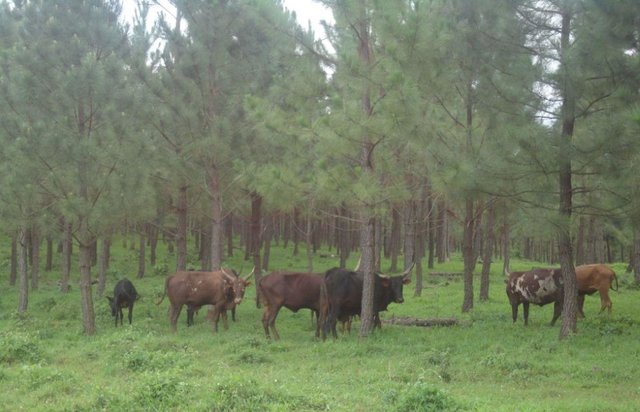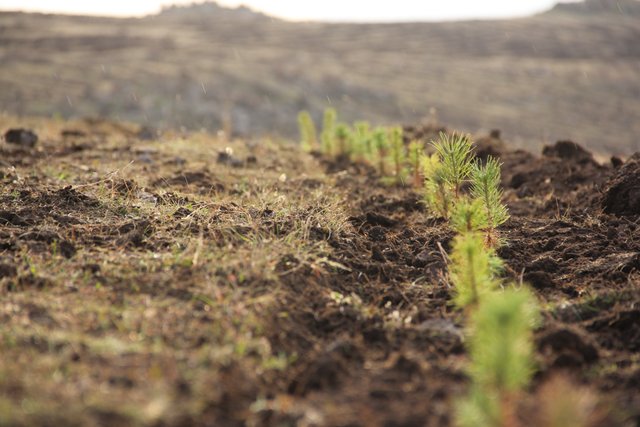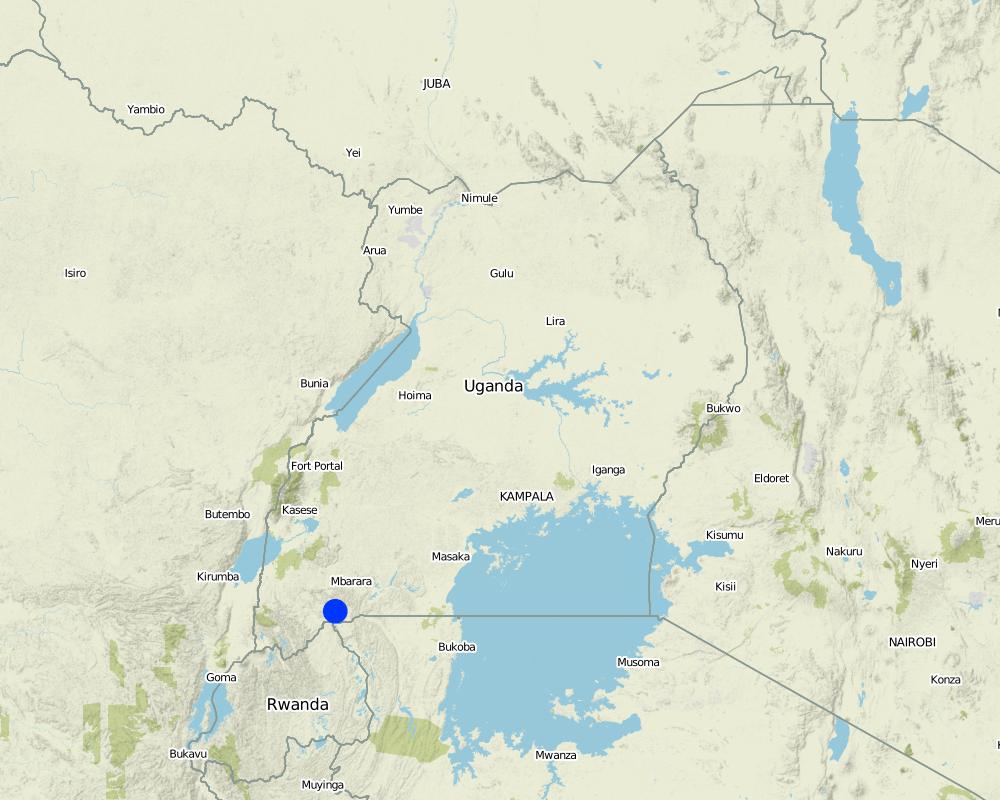Afforestation/Tree planting [ยูกันดา]
- ผู้สร้างสรรค์:
- การอัพเดท:
- ผู้รวบรวม: Wilson Bamwerinde
- ผู้เรียบเรียง: –
- ผู้ตรวจสอบ: Fabian Ottiger
Okuhinga emiti.
approaches_2587 - ยูกันดา
ดูส่วนย่อย
ขยายทั้งหมด ย่อทั้งหมด1. ข้อมูลทั่วไป
1.2 รายละเอียดที่ติดต่อได้ของผู้รวบรวมและองค์กรที่เกี่ยวข้องในการประเมินและการจัดเตรียมทำเอกสารของแนวทาง
ผู้เชี่ยวชาญ SLM:
Mazimakwo Kukundakwe
Kabale District
ยูกันดา
ผู้เชี่ยวชาญ SLM:
Mushabe Joshua
Ntungamo District
ยูกันดา
ผู้เชี่ยวชาญ SLM:
Tugaine Richard
Ntungamo District
ยูกันดา
ผู้เชี่ยวชาญ SLM:
Matsiko Polly
0782900819
Nshenyi, Kitwe Town Council
ยูกันดา
ชื่อของโครงการซึ่งอำนวยความสะดวกในการทำเอกสารหรือการประเมินแนวทาง (ถ้าเกี่ยวข้อง)
The Transboundary Agro-ecosystem Management Project for the Kagera River Basin (GEF-FAO / Kagera TAMP )ชื่อของโครงการซึ่งอำนวยความสะดวกในการทำเอกสารหรือการประเมินแนวทาง (ถ้าเกี่ยวข้อง)
Ntungamo District - ยูกันดาชื่อของโครงการซึ่งอำนวยความสะดวกในการทำเอกสารหรือการประเมินแนวทาง (ถ้าเกี่ยวข้อง)
Kabale District Local Government (Kabale District Local Government) - ยูกันดาชื่อของโครงการซึ่งอำนวยความสะดวกในการทำเอกสารหรือการประเมินแนวทาง (ถ้าเกี่ยวข้อง)
Kitwe Town Council - ยูกันดา1.3 เงื่อนไขที่เกี่ยวข้องกับการใช้ข้อมูลที่ได้บันทึกไว้ผ่านทาง WOCAT
วันที่เก็บรวบรวมข้อมูล (ภาคสนาม):
19/04/2013
ผู้รวบรวมและวิทยากรหลักยอมรับเงื่อนไขเกี่ยวกับการใช้ข้อมูลที่ถูกบันทึกผ่านทาง WOCAT:
ใช่
1.4 การอ้างอิงถึงแบบสอบถามเรื่องเทคโนโลยี SLM

Afforestation /Tree planting [ยูกันดา]
Pine tree forests have been strategically planted on previously bare ridges and slopes to mitigate mass soil movement.
- ผู้รวบรวม: Wilson Bamwerinde

High-altitude afforestation for erosion control [อาร์มีเนีย]
Afforestation is a key technologies to protect soil against erosion and provide a wide range of ecosystem services. In this case, afforestation at high altitudes, which is particularly challenging, with the primary purpose of erosion control were planted in small patches with different methods. They form the basis for future …
- ผู้รวบรวม: Hanns Kirchmeir
2. คำอธิบายของแนวทาง SLM
2.1 การอธิบายแบบสั้น ๆ ของแนวทาง
Tree planting carried out by individual land users on hilly slopes to improve soil cover ,reduce wind strength , provide wood fuel & household income.
2.2 การอธิบายอย่างละเอียดของแนวทาง
การอธิบายอย่างละเอียดของแนวทาง:
Aims / objectives: -To conserve the degraded hill by planting trees and reduce soil erosion.
-To reduce wind strength.
-To increase sources of fuel wood.
-To diversify sources of future household income.
Methods: -Mobilization of farmer field members to participate in tree planting , to increase tree cover in the area.
-Facilitation of planning meetings for farmer field school members in identifying tree planting needs.
-Purchase and raising of tree seedlings and tree nursery beds for tree seedlings.
-Distribution of tree seedlings to willing farmer school members for planting.
-Provision of training in tree planting technologies prior to distribution.
-Tree planting and management.
Stages of implementation: -Planning of tree planting needs.
-Purchase of tree seedlings and raising of indigenous tree seedlings.
-identification of planting sites.
-capacity building in tree planting technologies.
-making of holes for planting tree seedlings.
-Making of holes for tree planting seedlings.
-Planting of tree seedlings.
Role of stakeholders: -Mobilization of farmer field school members by service providers.
-Training the beneficiary members in tree planting by service providers/facilitators.
-Provision of funds for purchase of tree seedlings by FAO under the Kagera TAMP project.
Other important information: The land users and the farmer field school members had seen tree planting activities in neighbouring areas but they had thought that such activities could only be done by government.
But through mobilization farmers have realized the importance and possibility of farmers benefiting from tree planting.
2.5 ประเทศ ภูมิภาค หรือสถานที่ตั้งที่ได้นำแนวทางไปใช้
ประเทศ:
ยูกันดา
ภูมิภาค/รัฐ/จังหวัด: :
Uganda
ข้อมูลเฉพาะเพิ่มเติมของสถานที่ตั้ง:
Ntungamo
Map
×2.6 วันที่เริ่มต้นและสิ้นสุดของแนวทาง
ระบุปีที่เริ่ม:
2011
การสิ้นสุดลง (ถ้าแนวทางไม่ได้ใช้อีกต่อไป):
2015
2.7 ประเภทของแนวทาง
- ใช้โครงงานหรือแผนงานเป็นฐาน
2.8 เป้าหมายหรือวัตถุประสงค์หลักของแนวทาง
The Approach focused mainly on SLM with other activities (Reduction of wind strength ,provision of wood fuel and contribute to household income. )
-To conserve degraded hill slopes against erosion due to overstocking.
-To reduce wind strength in the area by increasing tree cover in the area.
-To increase source of wood fuel in the area.
-To diversify the future source of household incomes in the area among the communities.
The SLM Approach addressed the following problems: -To reduce soil erosion on degraded hill slopes.
-To reduce the strength of which wind affect the area in rainy seasons.
-To increase access to wood fuel sources.
-To diversify future household income.
-To get cheap timber for staking bananas.
2.9 เงื่อนไขที่เอื้ออำนวยหรือเป็นอุปสรรคต่อการนำเทคโนโลยีภายใต้แนวทางนี้ไปปฏิบัติใช้
บรรทัดฐานและค่านิยมทางสังคม วัฒนธรรม ศาสนา
- เป็นอุปสรรค
Lack of initiative to undertake tree planting.
Treatment through the SLM Approach: mobilization and sensitization into farmer field school approach.
การมีไว้ให้หรือการเข้าถึงแหล่งการเงินและบริการ
- เป็นอุปสรรค
Inadequate funds for tree seedling purchase.
Treatment through the SLM Approach: Seek assistance from FAO.
กรอบแนวทางในการดำเนินการด้านกฎหมาย (การถือครองที่ดิน สิทธิในการใช้ที่ดินและน้ำ)
- เอื้ออำนวย
The existing land ownership, land use rights / water rights greatly helped the approach implementation: Land user owns the land and thus did not face any resistance.
ความรู้เกี่ยวกับ SLM การเข้าถึงการสนับสนุนด้านเทคนิค
- เป็นอุปสรรค
Inadequate capacity on tree planting technologies and values in tree planting.
Treatment through the SLM Approach: Mobilization and training /sensitization in tree planting benefits.
3. การมีส่วนร่วมและบทบาทของผู้มีส่วนได้ส่วนเสียที่เกี่ยวข้อง
3.1 ผู้มีส่วนได้ส่วนเสียที่เกี่ยวข้องในแนวทางนี้และบทบาท
- ผู้ใช้ที่ดินระดับท้องถิ่นหรือชุมชนระดับท้องถิ่น
Farmer field school members , Facilitators
- ผู้เชี่ยวชาญ SLM หรือที่ปรึกษาการเกษตร
Farmer field trainers
- องค์การระหว่างประเทศ
- Facilitators
3.2 การเกี่ยวข้องของผู้ใช้ที่ดินระดับท้องถิ่นหรือชุมชนระดับท้องถิ่นในช่วงต่างๆของแนวทาง
| ความเกี่ยวข้องของผู้ใช้ที่ดินระดับท้องถิ่นหรือชุมชนระดับท้องถิ่น | ระบุผู้ที่มีส่วนเกี่ยวข้องและอธิบายกิจกรรม | |
|---|---|---|
| การริเริ่มหรือการจูงใจ | จ่ายเงินหรือสนับสนุนจากภายนอก | The land users were mobilized by national project coordinator. |
| การวางแผน | จ่ายเงินหรือสนับสนุนจากภายนอก | The land users were mobilized and facilitated to identify their problems related to environmental degradation & priorities were made. |
| การดำเนินการ | ระดมกำลังด้วยตนเอง | Land users were responsible for tree planting. |
| การติดตามตรวจสอบหรือการประเมินผล | จ่ายเงินหรือสนับสนุนจากภายนอก | Project officials are to undertake M&E. |
| Research | ไม่มี |
3.4 การตัดสินใจเลือกใช้เทคโนโลยี SLM
ระบุผู้ที่ทำการตัดสินใจเลือกเทคโนโลยีมากกว่าหนึ่งวิธีไปปฏิบัติใช้:
- ผู้ใช้ที่ดินเป็นผู้ตัดสินใจหลัก โดยการสนับสนุนจากผู้เชี่ยวชาญ SLM
การอธิบาย:
After mobilization and sensitization of the land users in farmer field schools ,the land users decided to under take tree planting.
Decisions on the method of implementing the SLM Technology were made by mainly by land users supported by SLM specialists. Land users made decision on the technology alone.
4. การสนับสนุนด้านเทคนิค การสร้างขีดความสามารถ และการจัดการด้านความรู้
4.1 การสร้างขีดความสามารถ / การอบรม
ได้มีการจัดอบรมให้แก่ผู้ใช้ที่ดินหรือผู้มีส่วนได้ส่วนเสียคนอื่น ๆ หรือไม่:
ใช่
ให้ระบุว่าใครเป็นผู้ได้รับการอบรม:
- ผู้ใช้ที่ดิน
รูปแบบการอบรม:
- เกษตรกรกับเกษตรกร
- ใช้พื้นที่ทำการสาธิต
4.2 การบริการให้คำแนะนำ
ผู้ใช้ที่ดินมีการเข้าถึงการรับบริการให้คำปรึกษาหรือไม่:
ใช่
ระบุว่ามีบริการให้คำปรึกษาหรือไม่:
- ที่ศูนย์ถาวร
การอธิบาย/แสดงความคิดเห็น:
Name of method used for advisory service: Training and awareness.; Key elements: mobilization, identification of problems related to land degradation. , Ranking of severity of land degradation types. SLM approaches were then selected by land users after analysis & synthesis of the problems.
Advisory service is inadequate to ensure the continuation of land conservation activities; Land use needs continuous follow-up and little support provided in terms of financial & advisory.
4.3 การเสริมความแข็งแกร่งให้กับสถาบัน (การพัฒนาองค์กร)
สถาบันได้รับการจัดตั้งขึ้นมาหรือเสริมความแข็งแกร่งโดยแนวทางนี้หรือไม่:
- ไม่
4.4 การติดตามตรวจสอบและประเมินผล
การติดตามตรวจสอบและประเมินผลเป็นส่วนหนึ่งของแนวทางหรือไม่:
ใช่
ความคิดเห็น:
technical aspects were regular monitored by land users through observations; indicators: Progress of tree growth.
There were few changes in the Approach as a result of monitoring and evaluation
There were no changes in the Technology as a result of monitoring and evaluation
4.5 การวิจัย
การวิจัยเป็นส่วนหนึ่งของแนวทางหรือไม่:
ใช่
- Baseline survey on the needs assessment.
ให้ข้อมูลเพิ่มเติมและให้ระบุผู้ทำการวิจัย:
Trainers of farmer field schools mobilized farmer field school land users ,who identified their problems and how they can be solved.
Research was carried out on-farm
5. การสนับสนุนด้านการเงินและวัสดุอุปกรณ์
5.1 ระบุงบประมาณประจำปีสำหรับแนวทาง SLM นี้
ถ้าหากว่างบประมาณประจำปีไม่เป็นที่ทราบแน่นอน ให้ระบุช่วงลงไป:
- < 2,000
แสดงความคิดเห็น (แหล่งของการระดมทุน ผู้บริจาคคนสำคัญ):
Approach costs were met by the following donors: international (FAO): 70.0%; local community / land user(s) (mobilization,facilitation of meals during trainings.etc): 30.0%
5.2 การสนับสนุนด้านการเงิน / วัสดุอุปกรณ์ให้แก่ผู้ใช้ที่ดิน
ผู้ใช้ที่ดินได้รับการสนับสนุนด้านการเงิน / วัสดุอุปกรณ์ไปปฏิบัติใช้เทคโนโลยีหรือไม่:
ใช่
5.3 เงินสนับสนุนสำหรับปัจจัยนำเข้า (รวมถึงแรงงาน)
- อุปกรณ์
| ระบุปัจจัยนำเข้าที่ได้รับการสนับสนุน | เห็นด้วยระดับไหน | ระบุเงินสนับสนุน |
|---|---|---|
| เครื่องมือ | ได้รับการช่วยเหลือทางการเงินบางส่วน | |
- การเกษตร
| ระบุปัจจัยนำเข้าที่ได้รับการสนับสนุน | เห็นด้วยระดับไหน | ระบุเงินสนับสนุน |
|---|---|---|
| ปุ๋ย | ได้รับการช่วยเหลือทางการเงินบางส่วน | |
ถ้าแรงงานโดยผู้ใช้ที่ดินเป็นปัจจัยนำเข้าที่มีอยู่มากมาย ระบุด้วยว่าเนื่องจาก:
- อาหารสำหรับการทำงาน
ความคิดเห็น:
Food for work, paid in cash and rewarded with other material support
Shs 5000 each person per day.
most funds provided by FAO and small proportion by land users.
5.4 เครดิต
มีการจัดหาเครดิตมาให้ภายใต้แนวทาง SLM หรือไม่:
ไม่ใช่
6. การวิเคราะห์ผลกระทบและการสรุป
6.1 ผลกระทบของแนวทาง
ช่วยให้ผู้ใช้ที่ดินนำเอาเทคโนโลยี SLMไปใช้และบำรุงรักษาสภาพไว้ได้หรือไม่:
- ไม่ใช่
- ใช่ เล็กน้อย
- ใช่ ปานกลาง
- ใช่ อย่างมาก
-Retardation of soil erosion. -Provision of soil cover.
ทำให้กลุ่มด้อยโอกาสมีอำนาจทางสังคมและเศรษฐกิจหรือไม่:
- ไม่ใช่
- ใช่ เล็กน้อย
- ใช่ ปานกลาง
- ใช่ อย่างมาก
No disadvantaged group involved.
Did other land users / projects adopt the Approach?
- ไม่ใช่
- ใช่ เล็กน้อย
- ใช่ ปานกลาง
- ใช่ อย่างมาก
2 to 7 land users adopted the approach towards tree planting.
Did the Approach lead to improved livelihoods / human well-being?
- ไม่ใช่
- ใช่ เล็กน้อย
- ใช่ ปานกลาง
- ใช่ อย่างมาก
Did the Approach help to alleviate poverty?
- ไม่ใช่
- ใช่ เล็กน้อย
- ใช่ ปานกลาง
- ใช่ อย่างมาก
The trees have not yet matured for harvesting.
6.2 แรงจูงใจหลักของผู้ใช้ที่ดินเพื่อที่จะนำ SLM ไปปฏิบัติใช้
- การผลิตที่เพิ่มขึ้น
- กำไร (ความสามารถ) อัตราส่วนค่าใช้จ่ายต่อผลประโยชน์ที่เพิ่มขึ้น
generate income.
- กฎและระเบียบ (ค่าปรับ) หรือการบังคับใช้
generate income.
- จิตสำนึกด้านสิ่งแวดล้อม
conserve the environment
- well-being and livelihoods improvement
6.3 ความยั่งยืนของกิจกรรมของแนวทาง
ผู้ใช้ที่ดินสามารถทำให้สิ่งต่างๆ ที่ได้ปฏิบัติใช้โดยแนวทางนี้ยั่งยืนได้หรือไม่ (โดยไม่มีการสนับสนุนจากภายนอก):
- ใช่
6.4 จุดแข็งและข้อได้เปรียบของแนวทาง
| จุดแข็ง / ข้อได้เปรียบของแนวทางในทัศนคติของผู้ใช้ที่ดิน |
|---|
| 1. Green environment (How to sustain/ enhance this strength: Plant more trees. ) |
| 2. Reduce global warming (How to sustain/ enhance this strength: Plant more trees for carbon absorption.) |
| 3. Cool environment (How to sustain/ enhance this strength: Plant more trees on the bare hills.) |
| 4. Increase productivity. (How to sustain/ enhance this strength: Better monitoring and evaluation. ) |
| จุดแข็ง / ข้อได้เปรียบของแนวทางในทัศนคติของผู้รวบรวมหรือวิทยากรหลัก |
|---|
| 1. Control of soil erosion. (How to sustain/ enhance this strength: Plant more trees. ) |
| 2.Improved soil cover. (How to sustain/ enhance this strength: Plant more trees. ) |
| 3. Reduction of wind speed. (How to sustain/ enhance this strength: Plant more trees in wind prone areas.) |
| 4. Increase wood fuel in future. |
6.5 จุดอ่อน / ข้อเสียเปรียบของแนวทางและวิธีในการแก้ไข
| จุดอ่อน / ข้อเสียเปรียบในทัศนคติของผู้ใช้ที่ดิน | สามารถแก้ไขปัญหาได้อย่างไร |
|---|---|
| 1. It is costly. | Subsidize land users. |
| 2. Long term returns. | Plant some quick maturing trees. |
| จุดอ่อน / ข้อเสียเปรียบในทัศนคติของผู้รวบรวมหรือวิทยากรหลัก | สามารถแก้ไขปัญหาได้อย่างไร |
|---|---|
| 1. It is costly to plant trees. | Provide subsides to land users who are practicing the technology. |
7. การอ้างอิงและการเชื่อมต่อ
7.1 วิธีการหรือแหล่งข้อมูล
- ไปเยี่ยมชมภาคสนาม การสำรวจพื้นที่ภาคสนาม
- การสัมภาษณ์กับผู้ใช้ที่ดิน
7.2 การอ้างอิงถึงสิ่งตีพิมพ์
ชื่อเรื่อง ผู้เขียน ปี ISBN:
1. Managemenrt plan for sawlog production ,Project proposal by Tibesigwa Mukasa,2006.
ลิงก์และโมดูล
ขยายทั้งหมด ย่อทั้งหมดลิงก์

Afforestation /Tree planting [ยูกันดา]
Pine tree forests have been strategically planted on previously bare ridges and slopes to mitigate mass soil movement.
- ผู้รวบรวม: Wilson Bamwerinde

High-altitude afforestation for erosion control [อาร์มีเนีย]
Afforestation is a key technologies to protect soil against erosion and provide a wide range of ecosystem services. In this case, afforestation at high altitudes, which is particularly challenging, with the primary purpose of erosion control were planted in small patches with different methods. They form the basis for future …
- ผู้รวบรวม: Hanns Kirchmeir
โมดูล
ไม่มีโมดูล


